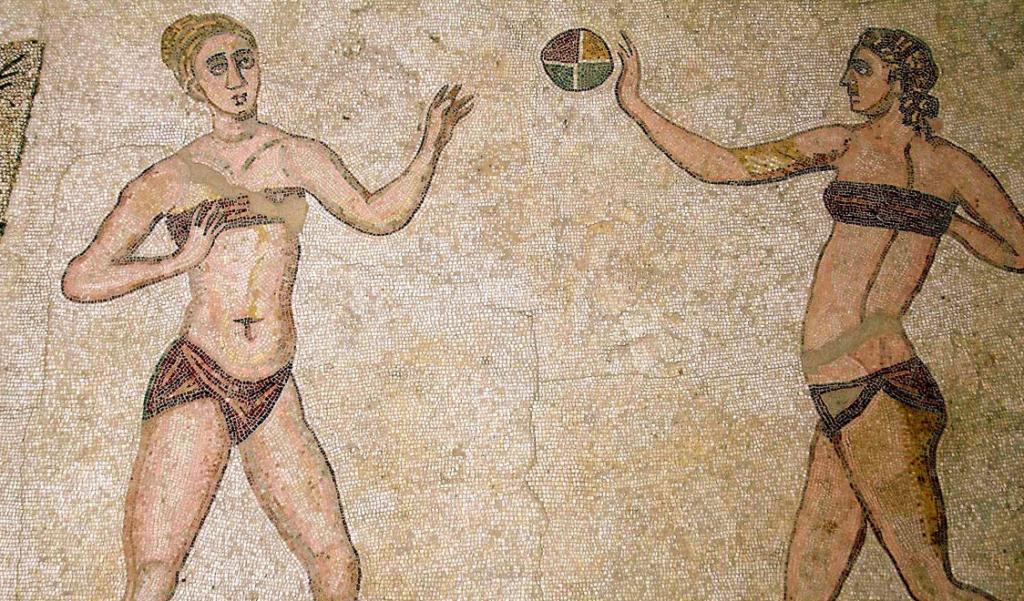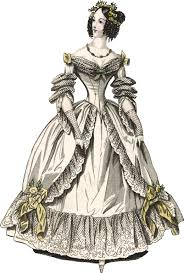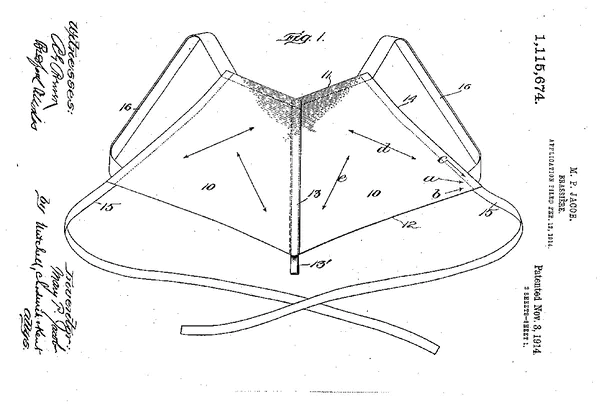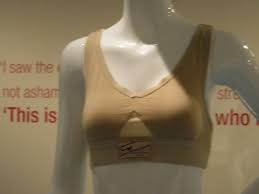Bras have come a long way from the rudimentary designs of the past; some of the ones on the market today are nothing short of an engineering marvel! They have had a long and difficult journey, that spans several centuries; varying from time period and from civilization to civilization, the history of bras is arguably just as long and complicated as the history of women and their place in this world; from their beginning in ancient times, bra-like garments were created with the purpose of covering, restraining or revealing breasts.
See also:
- 10 Surprising Facts About Bras
- 9 Bra Myths you must stop believing
- Bra Terminology – All You Need to Know
Unfortunately there seems to be no thought put into breast support or comfort that these garments provided. Breasts were sexualized, symbolized, and stigmatized without much thought put into what the owner of these breasts needed or felt; ah, the wonders of a patriarchal society.

Just a casual day at the beach I suppose…
Today, I feel as if there are already plenty of variations among the different kinds of bras on the market compared to last year! Bralettes, sports bras, and cup bras come in a variety of materials, colors and purposes, and overall, they are more comfortable and versatile garments than the instruments of the past. However, there are still definite limits to this market, with some very special niche brands being the only companies catering to bigger breasts and plus size women. Retail stores tend to lean towards bras for smaller breasts or bras that push up and expose more flesh, which only goes to show that we definitely have not managed to remove crazy beauty standards from the business of bras altogether. But we certainly have come a long way. Let’s take a look back on the history of bras:
Even though there are certain accounts that date the first bra to more than 3000 years ago, during the time of the Ancient Greeks, the general consensus is that the invention of the corset marks the beginning of the journey. And if you’re wondering why they aren’t around anymore, you can thank the metal shortage of World War I for removing that as an option! Before then, women squeezed themselves into corsets that molded their figures to fit the Victorian ideal; a voluptuous bosom and an entirely too small waist. But since corset frames were mostly made of metal, which was needed for ammunition and other military supplies, in 1917 the U.S. War Industries Board asked American women to stop buying them. It was estimated that the amount of steel needed to build corsets for a year, could have been used to build two battleships instead! Whatever the reason, we send our regards.
The first-ever bra most likely dates back to ancient Greece, when women wrapped a band of wool or linen across their breasts, pinning or tying them in the back; much like the strapless bra that exists today. They designed a piece of clothing to restrain breasts during physical activity, and it consisted of a band worn beneath and around the breasts -usually over the top of clothing- that partially supported the breasts while also pushing them up and completely exposing them. Although they were originally created with the intention of supporting and restraining the breasts for female athletes, bras at this time were mainly concerned with accentuating the breast as much as possible. Between then and the 15th century, when the corsets showed up, there aren’t any reliable records that suggest other such garments existed.

Once corsets were introduced as underwear, they quickly became mandatory for middle and upper class women in Western society. It involved impossible amounts of layers and the super-tight lacing of corsets created the illusion of extremely tiny waists, and fuller busts. Literature from this age is filled with ample descriptions of the horrifying lengths that women had to go through to adhere to the strict beauty standards of this era. What they failed to realize, or rather choose to disregard, was that this practice was ultimately damaging women’s bodies; scary signs of declining health like nausea, paleness, dizziness, fainting and even long term medical conditions were ignored in the name of fashion and female beauty standards. Women were, after all, “the weaker sex.” This trend went unchecked for over four centuries! Can you imagine women over the course of 400 years imprisoning themselves in this garment jail just because you were ‘supposed to?’ It was only by the end of the 19th century that things began to change; thankfully, with the beginnings of the feminist movement and the world wars just around the corner, women understood that the corset was not something that they could wear if they were to participate in more public roles. With this change in mentality, a lot of doors opened and eventually the prototype of the bra as we understand it today, was created.

Caresse Crosby, whose real name was Mary Jacob Phelps, designed the first modern bra in the U.S. in 1910. This story is the oldest one in the book, necessity is the mother of all innovation; while getting ready for a debutante ball, she donned a stiff and tight corset cover beneath her sheer evening gown. But the corset cover poked through her gown and she wouldn’t have any of it; “Bring me two of my pocket handkerchiefs and some pink ribbon,” she told her maid, who helped her sew the materials into a simple brassiere. Once she got there, Crosby’s invention was the talk of the party; other girls crowded around, asking how she danced so freely. When she unveiled her creation, they immediately asked her to sew bras for them too! Not surprisingly, when strangers began to offer her money in return for one of her bras, she decided to start a business and patented her ‘backless brassiere’ in 1914. She managed to attract a few orders from department stores, but she could not market her idea well enough at that point. At her husband’s insistence, Crosby sold her patent to the Warner Brothers Corset Company in Connecticut for $1,500.
Mary Jacob Philip’s backless brassiere
Over the next few years, the Crosby’s brassiere design was modified upon, but they were mostly a ‘one size fits all’ bra, that was fashioned from stretchable material. The cup system as it exists today, only came about in the late 20’s or early 30’s; some historians credit William and Ida Rosenthal, founders of Maidenform, with introducing the A-, B-, C- and D-cup system while others claim it was S.H. Camp and Company. Regardless of who slapped letters on women’s chests, the system caught on with other bra manufacturers.
As fashions evolved, so did the humble bra; when the androgynous flapper look came into vogue in the Roaring Twenties, the so-called bandeau bras – which flattened the breasts – became the popular choice. Later, in the 1930s, the bra industry took off, thanks to the adjustable elastic straps, padded cups and other innovations. Frederick Mellinger, founder of Frederick’s of Hollywood, was the genius behind the front hook bra and the ‘Rising Star’ – a precursor to today’s push-up bra. Nearly three decades later, childhood friends Lisa Lindahl, Hinda Miller and costume designer Polly Smith created the Jogbra, the first sports bra that was originally made out of two jock straps. It was designed in the midst of the feminist movement, that demanded that women be free from the confines of the bra and protested the garment as a torture device; it was one of the first bras that was created keeping in mind movement, comfort and support for the woman wearing it.

Today, nearly 95 percent of women in Western countries wear bras, which translates to a billion-dollar industry dominated by the likes of Victoria’s Secret and corporations like Hanes, Jockey and the such. Bra designers are now being challenged to satisfy the demand for minimal bras that accommodate plunging necklines and increasing bust sizes; studies have shown that in the past decade, the most common size in the U.K. jumped from 34B to 36C. Some of the bras that are sold in stores today really do take my breath away; to come from a silk handkerchief to a device that is calibrated to suit a certain chest type is nothing short of amazing. That being said, certain fashion historians are of the opinion that the bra is also on its way out, what with the increasing amount of disdain that is being shown to it. No doubt that the bra is a vehicle of patriarchy, designed to keep women’s breasts a certain way, but one cannot argue the benefits of making sure that they stay in their place as well. With movements like #FreeTheNipple that seem to be gathering traction the world over, and women questioning the social requirements of a bra, a bra-less future might not be too far off the mark!